Resource Exploration and Characterization
From reducing up-front exploration risk to improving reservoir operations, NREL's geothermal resource exploration and characterization research is focused on conventional and next-generation resources and technologies.
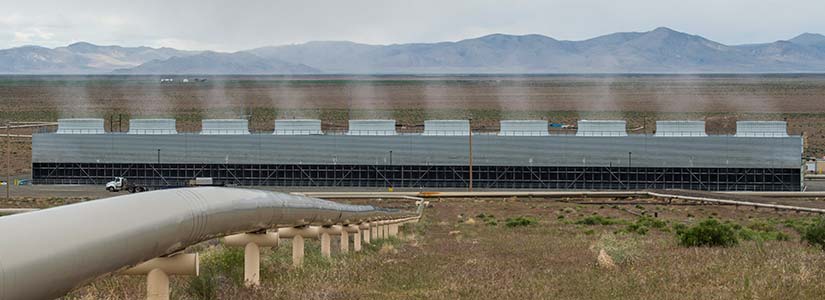
Humans have used geothermal systems for centuries for direct-heat applications such as cooking and heating. The earliest geothermal power plant was developed in 1904 in Lardarello, Italy, and it is still in use today. Next-generation geothermal technologies build on this history to develop innovations cutting across high-temperature reservoir modeling tools, novel resource assessment methodologies, data integration approaches and utilization efficiency, and conventional geothermal resources.
Reducing Resource Risk
Deciding where to drill for geothermal resources to optimize access to the heat beneath the surface is one of the biggest challenges of traditional geothermal development. NREL is working to reduce this risk for developers using advanced machine learning, the Play Fairway Analysis, and 3D geostatistics approaches for robust geodata integration and statistical analyses.
Play fairway analysis (PFA), adapted from the petroleum industry, is a systematic de-risking methodology that integrates quantitative geoscience data to identify prospective geothermal trends for further exploration. The U.S. Department of Energy has funded 11 projects to develop and test geothermal PFA approaches, with five projects ultimately progressing to the drilling phase. The projects identified undiscovered geothermal sites and prospective areas for additional analysis and directly informed several federal geothermal lease nominations. NREL is further developing additional PFA methodologies for geologic settings at a range of scales and different geothermal plays including superhot plays.
Resource Management
Optimizing geothermal reservoir performance and maximizing energy production over system lifetime requires proper resource management. NREL researchers develop geologic models, dynamic reservoir simulations including tools for superhot environments, and machine learning tools to assist operators and improve resource management. Power plant optimization focusing on next generation designs by simulating off design parameters is also a key aspect in NREL’s geothermal resource management research.
Superhot Rock Geothermal
Electricity production through conventional geothermal power plant technologies—such as binary, flash, and dry steam systems—typically requires temperatures between 100°C and 350°C, encountered at depths of less than 3 km. However, very few wells around the world drilled within these depth ranges have temperatures exceeding 250°C. The new frontier in geothermal development is now focused on drilling deeper, beyond 3 km, targeting superhot temperatures above 400°C, which promise significantly higher energy density per well.
One notable example is Iceland's IDDP-1 well, which aimed for depth of 4–5 km but encountered magma at just 2 km. Well test from this high enthalpy well (~450 °C) estimated an energy output up to 10 times that of a normal geothermal well. Understanding and harnessing these higher-energy resources could greatly improve the economics of geothermal energy development.
NREL is concentrating on advanced exploration methodologies and reservoir engineering tools to de-risk superhot geothermal resources. Additionally, it is conducting techno-economic analyses and exploring utilization approaches, including hybrid systems, to optimize the use of these high-temperature resources.
Sedimentary Geothermal Systems
Hot sedimentary basins throughout the U.S. have the potential to provide heat for direct use and, in some hotter basins, even for electricity. Because of extensive oil and gas development in many of these systems, their reservoir properties are often well characterized. NREL's resource assessment experts have identified significant potential in various basins and geopressured areas throughout the United States. As highlighted in the 2019 GeoVision study, these resources could provide as much as 7.5 million GWh of heat.
Machine Learning and Artificial Intelligence in Geothermal
Advancements in machine learning and artificial intelligence are creating opportunities for innovation and optimization in the geothermal industry. NREL is using the latest machine learning techniques and best practices in combination with our high-performance computing capabilities and geothermal expertise to create data-centric and physics-based tools that can solve complex problems in a matter of minutes. These innovative tools improve the accuracy and efficiency of geothermal exploration, reduce the cost of geothermal exploration, and optimize geothermal operations—driving down the overall cost of geothermal energy.
Mineral Recovery
Mineral extraction from geothermal brines and produced waters offers a secure, strategic, domestic source of lithium and other minerals needed for rechargeable batteries, from the ones in your smartphones to grid-scale energy storage systems. In addition, mineral recovery from hypersaline brines produced from seawater desalination can decrease freshwater cost, which will become more important as desalination becomes more common to address water scarcity in a warming climate. NREL researchers investigate the source and history of these brines and their interactions with associated rock formations, the global supply chain of critical minerals, and the techno-economics of recovery using different processes to develop novel technologies to extract critical minerals from unconventional resources.
Featured Projects
NREL launched a 2-year project that integrates physics-based modeling and machine learning to improve geothermal reservoir management. NREL researchers are improving subsurface characterization and modeling of fluid movement through geologic lithologies, fractures, and faults using our Eagle supercomputer. This project focuses on two difficult reservoir management decisions: where to drill and complete makeup wells and how to allocate injection into and production from new and existing wells.
Impact
This work closes the gap between annual geothermal generation and installed annual net generation capacity and reduces staff effort and computational time.
Partners
U.S. Geological Survey, Ormat, Heateon, CMG, and QRI
As the DOE-funded PFA projects varied in spatial extent, geologic setting, technical approach, data products, and reporting, NREL was tasked with determining the impact of the projects and comparing their outcomes. Our scientists evaluated metrics for measuring and valuing exploration knowledge, assessing remaining data gaps in publicly available national exploration knowledge, defining the typical characteristics of geothermal plays, and developing methodology best practices. These findings were released via a report for public use throughout the United States and abroad. Synthesizing the outcomes from the DOE-funded PFA projects and using them to produce a more standardized geothermal PFA methodology will enhance geothermal exploration practices and the rate of discovery going forward.
Impact
This project enabled us to understand how data reduce exploration risk, increase the discovery rate of geothermal resources by enhancing exploration practices, and support future geothermal PFA programs.
NREL partnered with the New Zealand company Upflow on the Geothermal Operational Optimization with Machine Learning (GOOML) project. The project team applied machine learning to decades of data from hundreds of wells at multiple power generation facilities—including steam, flash, and binary generators—from New Zealand’s massive Wairakei geothermal field, the multi-use Kawerau geothermal field, and McGinness Hills in the United States.
The GOOML project created “digital twin” system models and applied machine learning analysis of these large operational data sets. Findings from the models improved operations through optimization of daily processes, scheduling of critical asset maintenance, and prediction and detection of potential trouble events. Geothermal operators can use this technology to achieve a step change in the availability and efficiency of geothermal operations without drilling new wells or constructing new plants. This can reduce the levelized cost of electricity for existing and future geothermal installations and increase the economic competitiveness of geothermal.
Project results demonstrated increases in total power generation ranging from 2% to 11%.
Impact
Through GOOML, NREL seeks to improve the operational efficiency of geothermal power plant steam fields through the analysis of historical operational data and the development and application of physics-based machine learning algorithms.
Partners
New Zealand Energy Efficiency and Conservation Authority, Upflow New Zealand, Contact, Ngati Tuwharetoa Geothermal Assets, and Ormat
Techno-economic analysis of geothermal systems typically requires assumptions for reservoir and wellbore parameters such as producer-injector well ratio, production temperature drawdown, and production-injection temperature, pressure, and flow rate. To decrease uncertainty of these parameters, NREL analyzed field data from monthly production reports at 19 power plants in California and Nevada, covering 196 production wells and 175 injection wells. Read the full report.
Impact
This project resulted in a better understanding of reservoir operations and efficiency for U.S. operations on federal land.
Partners
Bureau of Land Management
NREL is partnering with international research institutions on the Geothermica-funded DEEPEN project to de-risk geothermal exploration in deep, supercritical magmatic plays. The project is developing a play fairway methodology specific to magmatic plays that includes the roots zone of the geothermal system (supercritical fluids, magma bodies, the brittle-ductile transition zone, and other elements). The project is also focused on developing new tools to help with subsurface imaging of deep and hot bodies.
Impact
This project could increase the power output of geothermal plants tenfold, significantly improving geothermal project economics.
Partners
Equinor, Reykjavik Energy, ISOR, NORSAR, Lawrence Berkeley National Laboratory, and other international research institutions
Capabilities
NREL works with industry partners to design and model widespread, cost-effective, and grid-friendly geothermal operations that will lower the cost of geothermal deployment. NREL's geothermal capabilities run the gamut from exploration and reservoir management to operations and from techno-economics to regulations and permitting. Learn more about how NREL's expertise supports the entire geothermal lifecycle.
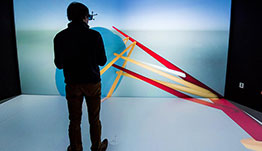
Our high-quality data resources, tools, management solutions, and visualizations advance the use of geothermal energy.
Data Resources and Tools
Geothermal Data Repository
The Geothermal Data Repository enables research, collaboration, and transparency by providing universal access to geothermal data. It provides free access to data generated from projects funded by DOE's Geothermal Technologies Office to facilitate the open transfer of knowledge, fuel innovation, reduce duplication of effort, and promote scientific discovery in the geothermal sector. The GDR now includes data lakes to enhance accessibility of especially large or complex datasets through cloud-based access and automated data pipelines to automatically standardize high-value datasets, improving the availability of high-quality data.
Data Foundry
The Data Foundry provides secure, cloud-based storage and universal access to digital information to enable the geothermal industry to collaborate with the Department of Energy, national labs, universities, and private organizations.
Publications
De-risking Superhot Enhanced Geothermal System Development Through 3D Play Fairway Analysis: Methodology Development and Application at Newberry Volcano, Oregon, USA, Geothermics, (2024)
Geothermal Play Fairway Analysis Best Practices, NREL Technical Report (2023)
Assessing Low-Temperature Geothermal Play Types: Relevant Data and Play Fairway Analysis Methods, NREL Technical Report (2023)
Low-Temperature Geothermal Geospatial Datasets: An Example From Alaska, NREL Conference Paper (2023)
The Data Foundry: Secure Collaboration for the Geothermal Industry, 45th Workshop on Geothermal Reservoir Engineering (2020)
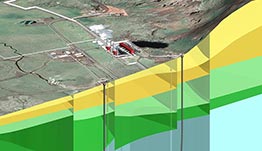
NREL's team of geothermal exploration experts has decades of experience in exploring for and identifying resources around the world.
A major challenge in traditional hydrothermal resource development is the high resource risk and the capital-intensive early phase of exploratory well drilling. Investors typically spend large sums before knowing with certainty whether an adequate resource exists. For this reason, de-risking drilling through effective pre-drilling exploration and targeting activities is important.
Our capabilities in exploration, subsurface characterization, and targeting span the spectrum of geothermal resources and end uses and include deep high-temperature and low-temperature hydrothermal, enhanced geothermal systems, and advanced geothermal systems, in different geothermal plays.
Publications
Sedimentary Geothermal Resources in Nevada, Utah, Colorado, and Texas, NREL Technical Report (2020)
GeoRePORT Case Study Examples: Reporting Using the Geothermal Resource Portfolio Optimization and Reporting Technique (GeoRePORT), Geothermal Resources Council Annual Meeting and Expo (2019)
An Estimate of Shallow, Low-Temperature Geothermal Resources of the United States, Geothermal Resources Council Annual Meeting and Expo (2016)
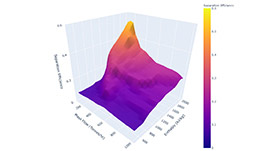
We use the latest machine learning techniques, best practices, high-performance computing capabilities, and our geothermal expertise to create data-centric and physics-based tools to solve complex problems.
Advancements in machine learning and artificial intelligence are creating opportunities for innovation and optimization in the geothermal industry. NREL is continuously researching the best ways to derive insights from data using machine learning and artificial intelligence, with solutions ranging from simple regression models to deep learning, encompassing genetic algorithms, reinforcement learning, and more. NREL is keen on maximizing the quality of the data used in these experiments as a means to maximize the quality of results, implementing solutions like data curation pipelines, automated data standardization, and data augmentation through generative machine learning.
These techniques are used in combination with our expertise in geophysics, geology, drilling, power conversion, electricity generation, and thermodynamics to generate artificially intelligent, data-centric and physics-based tools capable of improving:
- Subterranean resource characterization
- Discrete microseismic event identification and characterization
- Advanced drilling fault detection and fault prediction
- Optimization of steam field operations.
These innovative tools, adherence to best practices, and attention to the quality of the training data improve the accuracy and efficiency of geothermal exploration, reduce the cost of geothermal exploration, and optimize geothermal operations—driving down the overall cost of geothermal energy.
Publications
Distributed Sensing and Machine Learning Hone Seismic Listening Article, Eos Transactions American Geophysical Union (2022)
Geothermal Operational Optimization With Machine Learning, World Geothermal Congress (2020)
A New Modeling Framework for Geothermal Operational Optimization With Machine Learning (GOOML), Energies (2021)
Using Machine Learning To Predict Future Temperature Outputs in Geothermal Systems, Transactions (2020)
Which Geologic Characteristics Control Porosity and Permeability in Hydrothermal Reservoirs?, Transactions (2020)

We develop novel methodologies and workflows that capture and integrate disparate subsurface data to better define geothermal resources.
We apply our broad research and industrial experience to innovative analysis and assessment of geothermal resources to support government and industry efforts to advance geothermal discovery, development, and energy production.
Subsurface characterization extends from the surface down through reservoirs and beyond to understand geothermal resources ranging from shallow heat exchange and storage reservoirs to deep zones of supercritical fluids at the base of the seismogenic crust. With focus ranging from regional to prospect scale and through all phases of exploration and development, we aim to improve characterization of the subsurface environment by developing novel methodologies and workflows that capture and integrate disparate and limited subsurface data.
Publications
A Novel Approach to Map Permeability Using Passive Seismic Emission Tomography, World Geothermal Congress (2020)
NREL Flatirons Campus Geothermal Opportunities Assessment: Proposed Contributions to Integrated Energy Systems at Scale, NREL Technical Report (2020)
Sedimentary Geothermal Feasibility Study, NREL Technical Report (2017)
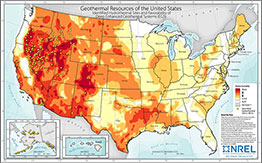
We produce high-resolution maps of worldwide geothermal resource potential as well as a national mapping interface to interact with geospatial datasets useful for geothermal development. NREL researchers are also advancing resource characterizations for temperature at depth and EGS potential.
Resource Characterization
Understanding resources is key to geothermal development. Although it's the United States Geological Survey's mission to study the U.S. geothermal resource, NREL takes its studies further to understand the technical, economic, and market potential and demand for these resources. NREL geoscientists review and analyze the resource potential of nontraditional resources, including traditional hydrothermal resources, supercritical resources, sedimentary and coproduced geothermal resources, enhanced geothermal resources (EGS), advanced geothermal resources, direct use resources, and shallow earth resources for geothermal heat pump and storage applications.
Mapping
NREL's geospatial data science research uses geographic information systems (GIS) to produce maps, analyses, models, applications, and visualizations that inform energy planning and production. We address critical challenges through cutting-edge practices, offering a unique perspective of the geospatial context surrounding contemporary geothermal issues and solutions. NREL data and visualization scientists integrate complex data sets into digestible, usable maps available for download or for use in our interactive Geothermal Prospector tool.
Publications
Sedimentary Geothermal Resources in Nevada, Utah, Colorado, and Texas, NREL Technical Report (2020)
GeoRePORT Protocol Volume II: Geological Assessment Tool, NREL Technical Report (2019)
GeoVision Analysis Supporting Task Force Report: Thermal Applications, NREL Technical Report (2019)
Geothermal Resources of the United States: Identified Hydrothermal Sites and Favorability of Deep Enhanced Geothermal Systems, NREL Map (2018)
An Estimate of Shallow, Low-Temperature Geothermal Resources of the United States, Geothermal Resources Council Annual Meeting (2016)

Our reservoir modeling team uses modeling tools for 3D static (structural) and dynamic (numerical) simulation, including thermal, hydrological, mechanical, and chemical properties. We engage our high-performance computing system to gain insights into the subsurface from well targeting to reservoir operations and from optimization to design of unconventional geothermal systems.
From traditional hydrothermal sites to new reservoir designs such as enhanced geothermal systems and closed-loop advanced geothermal systems, NREL scientists are advancing the science behind geothermal heat exchange. New reservoir designs could significantly reduce upfront project risk and allow for the development of geothermal anywhere in the United States.
NREL works with industry, academia, and other research institutions to model new, innovative reservoir designs to predict and analyze experimental and established reservoirs. Our researchers use cutting-edge modeling software such as CMG STARS, TETRAD-G, and the TOUGH2 suite of tools. Using the slender body theory, NREL has developed its own reservoir design optimization models for advanced geothermal systems to analyze large numbers of reservoir designs and well configurations while minimizing computational run time.
Publications
An Embedded 3D Fracture Modeling Approach for Simulating Fracture Dominated Fluid Flow and Heat Transfer in Geothermal Reservoirs, Geothermics (2020)
Sedimentary Geothermal Resources in Nevada, Utah, Colorado, and Texas, NREL Technical Report (2020)
Code Modifications for Modeling Chemical Tracers and Embedded Natural Fractures at Enhanced Geothermal System Collab, Stanford Geothermal Workshop (2019)
Analysis of Geothermal Reservoir and Well Operational Conditions Using Monthly Production Reports from Nevada and California, Transactions (2017)
Slender-Body Theory for Transient Heat Conduction: Theoretical Basis, Numerical Implementation, and Case Studies, Proceedings of the Royal Society A (2015)
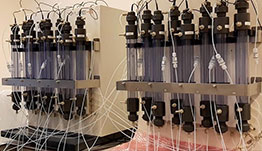
NREL is developing new, energy-efficient technologies that will address the challenges of mineral separation.
On average, separations account for 20%–40% of production cost and dominate energy consumption in chemical and mining processes.
Our areas of separation science research include:
- Advanced mineral separation technologies
- Nonthermal dewatering technologies
- Purification of bioproducts from fermentations
- Purification of natural products from plant extracts
- In situ product recovery from fermentations and chemical reactions
- Gas phase separations.
Publications
In Situ Product Recovery of Bio-Based Ethyl Esters via Hybrid Extraction-Distillation, Green Chemistry (2019)
Reducing Energy, Solvent, and Resin Demand of Sorption-Based Processes for Carboxylic Acid Recovery, American Institute of Chemical Engineers Annual Meeting (2019)
In Situ Recovery of Bio-Based Carboxylic Acids, Green Chemistry (2018)
Post-Fermentation Recovery of Biobased Carboxylic Acids, American Chemical Society Sustainable Chemistry & Engineering (2018)
NREL scientists explore geothermal technologies for creating fresh water from otherwise unusable water. Although most desalination processes use reverse osmosis membranes, thermal desalination processes can provide additional capacity and reduce waste in many applications. Thermal desalination is often constrained by the cost of heat, but geothermal energy can provide otherwise unused, renewable heat. Applied in the right locations, thermal desalination could mean economic viability for water treatment.
More research is needed before geothermal desalination is cost-effective. However, advances have been made in producing high-quality water from geothermal brines at lower cost than traditional thermal distillation, and membrane coatings have shown the ability to minimize and remove undesired scale formation.
Share

